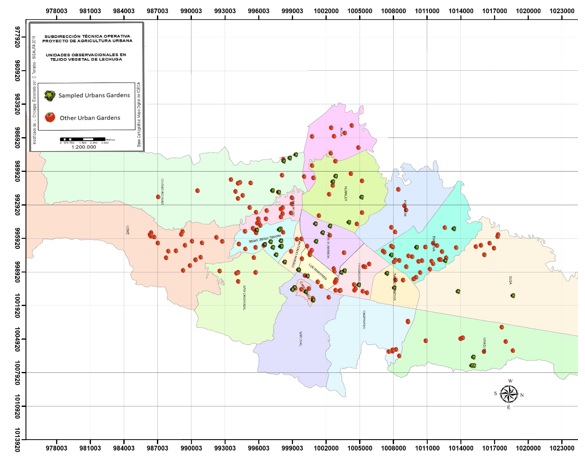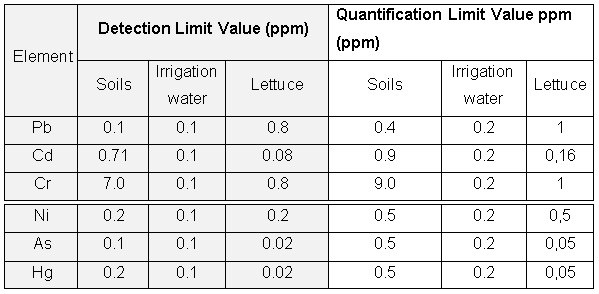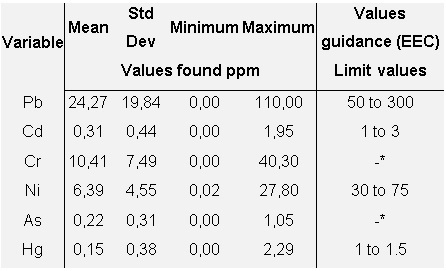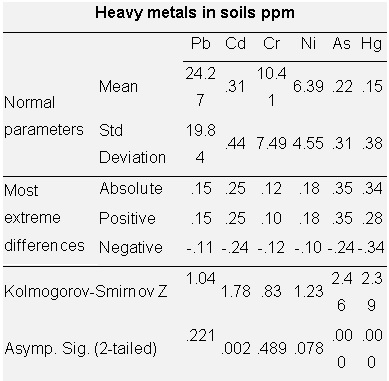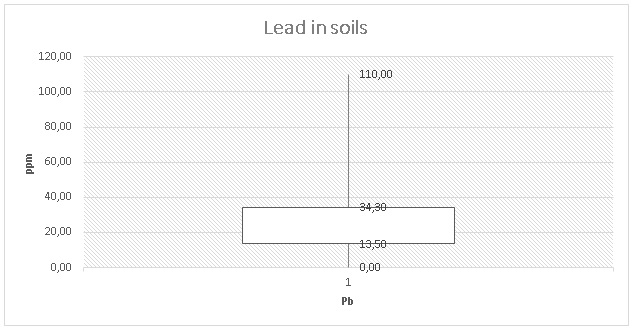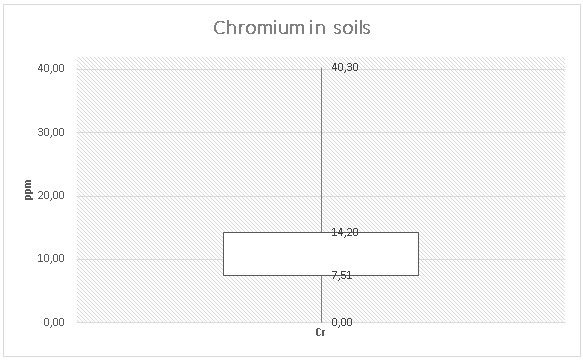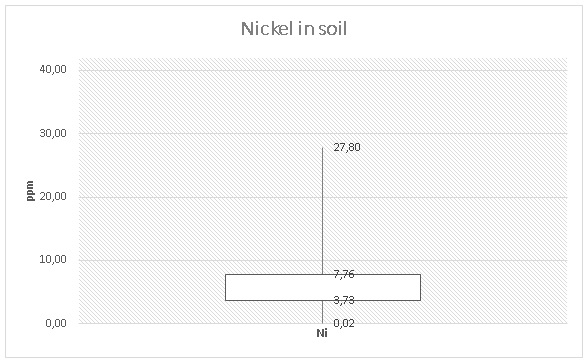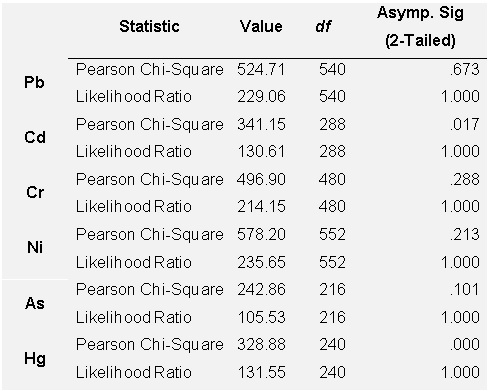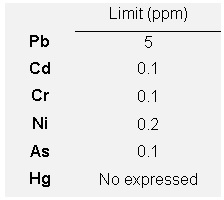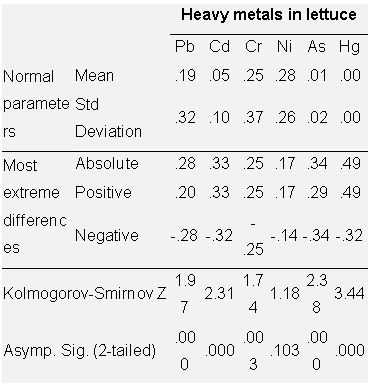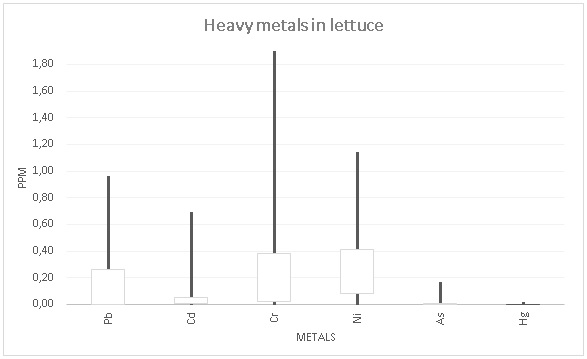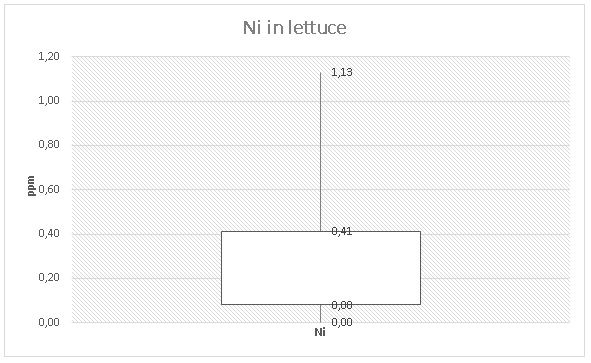|
Levels of heavy metals. Urban gardens in Bogota Colombia
Daniel A. Vega Castro1
Recibido: 10 de Mayo del 2021 Aceptado: 10 de Agosto de 2021 Actualizado: 27 diciembre de 2021
DOI: 10.17151/luaz.2022.54.6
Abstract
Samples of lettuce, soil, and irrigation water from city gardens located in Bogota were analyzed in order to detect and quantify lead (Pb), cadmium (Cd), chromium (Cr), nickel (Ni), arsenic (As) and mercury (Hg). Metal concentrations of the soils and vegetables varied according to urban garden location; all detected metals in the soils and the lettuce were below health-based guidance values (local and international standards); heavy metals in irrigation waters were not detected; soils, metal concentrations of the irrigation waters and lettuce did not correlate. It means that urban agriculture should not represent a significant chemical risk for the consumer’s healthcare due to the possible intake of heavy metals and trace elements. However, it is necessary to continue conducting research on this important topic that is directly related to food security and food sovereignty and that will add information to update and establish a basis for reference levels regarding heavy metals in water, soil and vegetables.
Keywords: heavy metals, soil, urban agriculture, rainwater harvesting, food security.
Resumen
Se analizaron muestras de lechuga, suelo y agua de riego en huertos urbanos de la ciudad de Bogotá para la detección y cuantificación de plomo (Pb), cadmio (Cd), cromo (Cr), níquel (Ni), arsénico (As) y mercurio (Hg). Las concentraciones de metales de los suelos y hortalizas variaron según la ubicación del huerto urbano; todos los metales detectados en los suelos y la lechuga estaban por debajo de los valores permisibles de referencia (estándares locales e internacionales); no se detectaron metales pesados en las aguas de riego; suelos, concentraciones de metales de las aguas de riego y lechuga no se correlacionaron, lo que permitió concluir que, la agricultura urbana no debe representar un riesgo químico significativo para la salud de los consumidores por la posible ingesta de estos metales pesados y/o elementos traza. No obstante, es necesario continuar investigando sobre esta importante temática, la cual se relaciona directamente con la seguridad y soberanía alimentaria, que debería permitir actualizar y/o generar bases para el establecimiento de niveles de referencia frente al contenido de metales y elementos traza en aguas, suelos y alimentos hortofrutícolas.
Palabras claves: metales pesados, suelo, agricultura urbana, aprovechamiento de aguas pluviales, seguridad alimentaria.
Introduction
By 2030, 60% of the world's population will inhabit urban areas, according to FAO, which will expand large cities to fertile land. According to the 2018 Sustainable Development Goals Report, urban expansion is progressing at a rate of 1.5 times higher than the population growth. This indicates the need to make cities inclusive, safe, resilient and sustainable, involving the three dimensions of sustainable development: social, economic, and ecological well-being. In response, the use of eco-materials, urban agriculture, gardens, living walls and green roofs, rainwater and sustainable urban drainage systems, among many others, have been increasing (United Nations, 2019).
Urban agriculture can be defined as a set of agricultural practices carried out in urban spaces within a city or in its surroundings (peri-urban) in hard or soft areas such as front gardens, lots, terraces, patios, backyards, kitchens etc. These physical places allow using technical and empirical knowledge in addition to articulating available resources. This aims not only at food security and sovereignty, but also at strengthening the social system, the recovery of vacant land, the participation of citizens in environmental sustainability and mitigation of problems caused by climate change (Vega, 2016).
Innocuous vegetables grown through this practice play a decisive role regarding food security. It is noteworthy that there are certain risks of contamination in urban vegetable production (Castro et al., 2018). Contamination, in the specific case of food, is defined by Gay (2017) as: “the presence of any abnormal matter in the food that compromises its quality for human consumption” (p.142).
There are many risks of vegetable contamination. One of those is related with the accumulation of heavy metals inside the edible organs such as leaves, tubers, stems, fruits, and flowers. These chemical elements can come from cultivated soil, irrigation water, agricultural supplies, and the atmosphere. (Vega and Vega, 2020).
Soils can contain heavy metals for two specific reasons. First, due to natural origin (geogenic): when parent materials had been weathered, and the rocks had heavy metals. Second, due to anthropogenic issues: through industrial activities, hydrocarbons combustion, mining, agriculture and livestock, which generate heavy metals during these processes.
Authors such as Angelova et al. (2004) define bioaccumulation as the increase in the concentration of a chemical in a living organism over a certain period of time, compared to the concentration of that chemical in the environment. Heavy metals can be accumulated in the body up to five times greater than the concentration of the medium from which it comes (Galán & Romero, 2008).
Vegetables have developed multiple mechanisms for the absorption, translocation, transformation, and accumulation of mineral elements. Among these forms, the absorption of minerals through the root system and the leaf tissue stand out. Through roots and their absorption system, plants can transport substances from the soil to the different plant organs.
Vegetables with heavy metal accumulation generate considerable impact on the health of consumers due to the effects of bioaccumulation and the high toxicity of these elements. They also cause damage to vital organs and carcinogenic developments, depending on the metal or metalloid and the degree of accumulation in the organism (Combariza, 2009; Nava and Méndez, 2011).
Sánchez (Quoted by Reyes et al., 2016) affirm that global cases have been reported and demonstrate the health consequences of consuming food contaminated by heavy metals. By 1950, the population along the banks of the Jintsu River in Japan was affected by rice consumption from crops contaminated with cadmium (Cd) from mine dumping. This intake produced a disease known as Itai-Itai or osteoarthritis, which mainly affects bone tissue.
Additionally, in the city, crops near the road were polluted by heavy metals, with up to 160 mg per kilogram of dry weight for lettuce (Antisari et al., 2015). In the case of Canada, concentrations of the heaviest metals were below the limits established by nationals regulations, metals like Cd, Pb, Se and Zn exhibited a mild degree of pollution, whereas As exhibited a severe degree (Montaño-López and Biswas, 2021). The United States Department of Agriculture USDA (2010), states that soils in community gardens in urban areas can be severely contaminated with heavy metals, and it is necessary to determine the amounts and bioavailability of these toxic elements in soils in urban areas in order to properly assess the risks associated with gardening in these areas and develop rational remediation strategies to reduce the risks.
Therefore, this research work focused its efforts on identifying the possible risks of the consumption of vegetables produced by urban agriculture in comparison with local and international guidance values. The overall goals of the study were to identify and quantify levels of Pb, Cd, Cr, Ni, As and Hg in vegetables and their relationship with soils and irrigation water variables.
Materials and methods
Location This study was carried out in Bogotá D.C. This city has the highest automotive fleet in Colombia. The most recent studies in this area revealed an average annual increase of 4.1% in registered vehicles (87,802), which reflects that Bogotá is the city of Colombia with the highest number of vehicles in the last 10 years (Colombia Mobility secretary, 2016).
One hundred urban gardens of the city were located and visited, 49 of them were taken to carry out the respective samplings of vegetables, soils and irrigation waters, which allowed us to work with a measurement error of 10% and a significance of 94%. The study was carried out in 13 of the 20 subdivisions of Bogotá, also called localities (Figure 1). The study was divided into four zones according to their geographical location. South: Rafael Uribe Uribe and Ciudad Bolívar. East: Antonio Nariño, Candelaria, Los Mártires and Santa Fe. North: Engativá, Teusaquillo, Barrio Unidos, Suba and Usaquén. West: Kennedy and Puente Aranda.
Urban gardens were selected based on four standards of placement: away from contaminated rivers, near high vehicular flow routes (distances not greater than 2000 feet), located throughout Bogotá DC and soon- to-be harvested lettuce.
It is noteworthy to mention that the selected urban gardens have agroecological management and are assisted from the technical area by the Botanical Garden José Celestino Mutis JBB from Bogota. Furthermore, these places do not use chemical synthesis inputs for pest management or for soil fertilization. Figure 1. Location of tracked urban gardens and sampled urban gardens in Bogota Source: Botanical Garden Jose Celestino Mutis from Bogota, 2019 Hacer click sobre la imagen para ampliarla
Soil samples and analysis Samples of soils were taken in each one of the urban gardens selected for the identification of Pb, Cd, Cr, Ni, As and Hg. The Soil Sampling Guideline of the Colombian Corporation for Agricultural Research - CORPOICA- was followed. This analysis was performed to rule out or corroborate the presence of heavy metals in soils. The 49 soil samples taken were sent in hermetic security bags to the laboratory for their respective preparation and analysis.
The selected samples were analyzed using the Atomic Absorption Spectroscopy technique AAS (Flame Air Acetylene), under EPA methods 3050B, EPA 7471B, (1996) and SM 3111 B, 3112 B and 3114 C Ed 22 (Standard Methods). These parameters were evaluated in accordance with Colombian Technical Standard 5167 NTC, Agricultural Industry Products. Organic Products Used as Fertilizers and Soil Amendments.
Irrigation water samples and analysis The water was collected from the respective sources of irrigation from the selected urban gardens: aqueduct and rainwater harvested. For this purpose, specific samples were taken based on the methodology proposed by the National Institute of Health of Colombia, in the instructions Manual for Taking Water Samples for Laboratory Analysis. This analysis was performed to rule out or corroborate the presence of heavy metals in irrigation water. To collect the samples, 500 mL amber borosilicate bottles were used and then taken to the laboratory to carry out their respective treatment and corresponding analysis.
The analysis carried out for the identification of heavy metals in irrigation waters was carried out using the AAS/Flame Air Acetylene, following the SM 3030 E edition 22 sample preparation methodologies and SM 3111 B quantification. - Edition 22.
Vegetable samples and analysis Lettuce (Lactuca sativa L.) plants were harvested for three specific reasons: (1) it is one of the most popular market basket items of the Bogota inhabitants, (2) it is a common plant in urban gardens and (3) its leaves are the organ of direct consumption. Three lettuce plants were randomly sampled for each selected place. They were harvested using tramontin-type stainless steel knives. Those samples were packed and transported in Kraft paper bags and taken directly to the laboratory for the respective laboratory tests.
The identification of heavy metals in plant tissue was carried out under the AAS, under AOAC 975.03B (1990) and SM 3111 B 3114 C edition 22. The equipment used for the determination of heavy metals in the Matrix was a model AA-7000 atomic absorption spectrophotometer for analysis by air acetylene flame.
The analytical quality parameters of the methods used for detection limits and the quantification limits of heavy metals (Table 1) were stipulated for each of the variables analyzed: soils, irrigation water and lettuce plant tissue. Table 1 Analytical quality parameters of the heavy metals studied
Source: authors
Statistical analysis For statistical analysis and hypothesis testing, the PSPP® Program was used. A normality test was initially done using the Kolmogorov Smirnov non-parametric statistic to assess whether the data presented a normal distribution. Thus, it was possible to draw statistically valid conclusions from the descriptive statistics, which are based on a working hypothesis study that the distribution of the variables is different from the normal one.
In addition, tests of independence were performed using the Pearson's Chi square test to check the relationship between these variables: contents of Pb, Cd, Cr, Ni, As and Hg found in soils, irrigation water, plant tissue and the respective 13 localities sampled. These variables are contingent upon a working hypothesis that the variables are related.
Finally, the correlation between the variables was evaluated using the Pearson coefficient to identify if it was strong, moderate or weak among the contents of Pb, Cd, Cr, Ni, As and Hg found in the soil, water of irrigation and the respective vegetal tissue of the lettuce, which is also contingent upon a working hypothesis that the variables are correlated. In all cases, a significance of 5% is necessary to accept or reject the null hypothesis.
Results and discussion
Soil results The respective descriptive statistics of heavy metals and trace elements (Table 2) showed that out of the six elements evaluated in the sampled soils, three: Pb, Cr, and Ni have the highest concentrations, averaging 24.27 ppm, 10.41 ppm, and 6.39 ppm respectively. However, these elements do not present anomalous concentrations and therefore, all those metals should have geogenic origin derived from the respective parent materials and possible volcanic activities when presenting values well below those established by norm 86/278 of the EEC (European Economic Community).
For Cd, As and Hg in soils, no outliers that exceeded the EEC regulations were found. Heavy metals, specifically trace elements, are present in the earth's crust in relatively low concentrations (ppm) and therefore, in the soil as well (Galán and Romero, 2008). Table 2 Descriptive statistics of metal contents in soils (n=49) Note: *Values are not presented in the standard Once the normality test was performed, enough statistical evidence was not present to reject the hypothesis. The distribution of the variables Pb, Cr and Ni in the soil was equal to normal under a significance of 5% (Table 3). In other words, of all the heavy metals and trace elements tested in the different soils of Bogotá, only Pb, Cr, and Ni showed normal behavior. Table 3 Kolmogorov-Smirnov one sample test (n=49) Source: authors
The average concentration of Pb showed a value of 24.27 ppm. Its values ranged from 0 to 110 ppm / Pb (Table 1) where 68.3% of the sampled units presented values between 4.43 and 44.12 ppm / Pb. It is noteworthy that for this variable, 25% of the soil samples yielded values between 0 and 13.50 ppm / Pb, 50% of the results found yielded lead contents between 13.50 and 34.30 ppm / Pb and for the remaining 25%, the levels found ranged from 34.30 to 110 ppm / Pb (Figure 2). Otherwise, EPA (United States Environmental Protection Agency) determined that the maximum values of Pb in soils for agricultural and industrial use should range between 400 and 1200 ppm. The regulation 86/278 of the EEC (European Economic Community) established a limit values of this heavy metals in soils with a maximum range of 300 ppm. Based on the above information, it can be stated that the Pb found in the sampled soils presented values within normal limits when these are compared with the international standards. Best management practices assure minimal potential for exposure and are common practices in urban gardens. These include the use of residuals-based composts and soil amendments and attention to keeping soil out of homes. This review suggests that benefits associated with urban agriculture far outweigh any risks posed by elevated soil Pb (Brown et al., 2016).
Figure 2. Lead levels in soils sampled in the different localities of Bogotá. D.C. Source: authors
Regarding Cr in soil, the results of this work of research yielded maximum values of 40.3 ppm and an average of 10.41 ppm. In addition, it was evident that 50% of the samples analyzed showed a behavior with a low amplitude with values between 7.51 and 14.20 ppm/Cr (Figure 3). For this specific case, there are no international reference frameworks that regulate the levels of this trace element in the soil.
However, it should be noted that Chromium is generally found naturally in soils and the respective amounts are directly related to the parent material of soil formation. Histosol and other organic soils have relatively low Cr contents. However, there are soils that naturally contain much more Cr and are derived from ultramafic or mafic rocks very rich in this element (Fernández and Guzmán, 2000). Figure 3. Chromium levels in soils sampled in the different localities of Bogotá. D.C. Source: authors
The Ni concentrations showed an average value of 6.39 ppm in the soil (Table 1). 50% of the results found showed contents between 7.51 and 14.20 ppm/Ni with a maximum of 40.3 ppm/Ni that was evident (Figure 4). Ni is an element that occurs in the environment only at very low levels and is essential in small doses, but it can be dangerous when the maximum tolerable amounts are exceeded (Wuana & Okieimen, 2011). With this research, all results show that the contents of this trace element do not present abnormal values according to the EEC and the 86/278 regulation, which stipulates a limit value of 75 ppm of Nickel in the soil.
Figure 4. Nickel levels in soils sampled in the different localities of Bogotá. D.C.
Source: authors
In the case of the variables that did not present a normal distribution, independence tests were carried out (Table 4). Under a significance of 5%, sufficient statistical evidence has not been found to reject the hypothesis that the variable locality is independent of the variables Pb, Cr, Ni and As in soil. That is to say that the levels of these heavy metals and trace elements found in the soil are not related to the sampled locality. Additionally, a relationship between Cd, Hg and localities is observed. Table 4 Person Chi-square tests Locality vs Heavy metals (n=49) Source: authors
A bivariate correlation was performed (Pearson's correlation coefficient) to identify whether there is a strong, moderate, or weak relationship between the contaminants of the plant tissue and the planting soil.
It is observed that the significance is greater than the alpha error (0.05) and that the Pearson coefficient is close to zero. Therefore, it cannot be pointed out that there is an association between the variables of the plant tissue contaminants and the planting soil. That is if the levels of the heavy metals and trace elements found in lettuce are not related to the levels of the elements found in the soil.
It is noteworthy that there are multiple factors such as pH and the content of organic matter among other soil properties that affect the solubility of these metals and therefore their bioavailability (McBride et al., 2014). The presence in soil of clays and hydrous Fe and Mn oxides tends to increase metal adsorption and thus reduce soluble metal contents, while the effects of organic matter content and redox potential are more uncertain. (Rieuwerts et al.,1998).
It should be noted that to date, in the case of Colombia, there are no regulatory frameworks that monitor and regulate the contents of heavy metals and trace elements in soils.
Irrigation water results
Rainwater harvesting (RWH) has been used globally to address water scarcity for various ecosystem uses including crop irrigation requirements and to meet the water resource needs of a growing world population. (Ghimire and Johnston, 2019). In the case of Colombia, Decree 1594 of 1984 establishes the admissible criteria in ppm of heavy metals and trace elements in water for agricultural use (Table 5). Table 5 Heavy metal limits for irrigation water Department of agriculture of Colombia
Source: authors
Studies have demonstrated that although trace metals such as arsenic, cadmium, chromium, lead and iron were present in Australian rainwater, the metallic elements were generally found below the health limit guideline (Chubaka, et al., 2018). For the present study, the waters used for irrigation in the selected orchards resulted in the non-detection of heavy metals and trace elements. However, the roofing material plays an important role in the concentrations of rainwater pollutants. (Torres et al., 2013). Therefore, the water contact surfaces, the transportation ways and rainwater harvesting containers play a very important roll about water quality and its possible pollution with heavy metals.
Vegetables results
Once the normality test was performed, sufficient statistical evidence was found to reject the hypothesis that the distribution of the variables Pb, Cd, Cr, As and Hg in plant tissue is equal to normal (Table 6). These variables were under a significance of 5%. The only variable that presented normality was Ni in plant tissue. Table 6 One-Sample Kolmogorov-Smirnov Test (n=49) Source: authors
All lettuce samples showed different heavy metals contents (Figure 5) that could suggest possible risks for consumers’ health. However, all values of Pb, Cd, Cr, Ni, As and Hg were found far below European Union Regulation’s maximum contents of heavy metals in food. Figure 5 Heavy metals levels in lettuce sampled in the different localities of Bogotá. D.C. Source: authors
In the case of the amounts of Ni found in plant tissue, a statistic test was performed (Table 7) obtaining as a result, a maximum value of 1.13 ppm and an average of this heavy metal being 0.28 ppm. In addition, a distribution of the contents of this element was obtained in the following way: 25% of the samples yielded values between 0 and 0.08 ppm / Ni, 50% between 0.08 and 0.41 ppm / Ni and the remaining 25% values between 0.41 and 1.13 ppm / Ni (Figure 6).
Figure 6 Nickel levels in lettuce sampled in the different localities of Bogotá. D.C. Source: authors
Based on the above, it can be ensured that the maximum Ni content found in plant tissue is well below the permissible limits stipulated by Australian and New Zealand (2016) heavy metal legislation, with a value of up to 5 ppm of Ni in food.
Conclusions In the case of the soils analyzed for food production in urban gardens, it was found that heavy metals and trace elements are below national and international regulations. However, it is of utmost importance to generate and/or update levels of reference that allow differentiation of the geogenic (normal) values from the anthropogenic (anomalous) levels to avoid greater biases in research associated with the possible chemical risks that urban agriculture can generate.
The variables analyzed in vegetable tissue of lettuce show that that in the case of the present study, urban agriculture should not generate a chemical risk for consumers due to the possible consumption of heavy metals and therefore, should be taken into account in local plans for the development of cities and expanding their positive contributions to food security and sovereignty that this practice proposes.
Results found in the rainwater harvested for the irrigation of vegetables in urban gardens allow us to conclude that it is completely safe for agricultural use since no heavy metals or trace elements were found for the detection limits. It is recommended to delve deeper in studies regarding this variable, which allows us to conclude the best areas for harvesting and storing this type of water in order to generate guidelines for the optimization and reduction of chemical risks associated with this variable.
In the urban gardens of the city of Bogotá, more than 100 species are managed including vegetables, tubers, cereals, legumes and fruits as well as non-food products, which include aromatic and medicinal plants, among others, so it is important to verify the levels of heavy metal contamination considering the different species and different plant organs such as stems, flowers and roots.
Highlights Soil and vegetable metal concentrations did not correlate. Soil metal and localities did nor correlate. Soil metal levels showed values bellowed of EPA and EEC regulations. Lettuce metal did not exceed the market-basket levels and guidance values (EEC standards). Rainwater harvested did not show pollution with metals.
Acknowledgments The authors thank the urban farmers of the capital, to the Botanical Garden of Bogotá José Celestino Mutis and to the Corporación Universitaria Minuto de Dios UNIMINUTO for the financing and support provided for the development of this project.
References
Angelova, V., Ivanova, R., Delibaltova, V. & Ivanov, K. (2004). Bio-accumulation and distribution of heavy metals in fibre crops (flax, cotton and hemp). Industrial crops and products, 19(3), 197-205.
Antisari, L., Orsini, F., Marchetti, L., Vianello, G., & Gianquinto, G. (2015). Heavy metal accumulation in vegetables grown in urban gardens. Agronomy for Sustainable Development, 35, 1139 –1147. https://doi.org/10.1007/s13593-015-0308-z
Australia New Zealand Food Standards Code. (2016). Schedule 19 – Maximum levels of contaminants and natural toxicants (pp. 1–7). Attorney-General’s Department.
Botanical Garden of Bogota José Celestino Mutis. (2018). Technical and Operational Subdirection. Urban Agriculture Project.
Brown, S. L., Chaney, R. L., & Hettiarachchi, G. M. (2016). Lead in Urban Soils: a Real or Perceived Concern for Urban Agriculture? Journal of environmental quality, 45(1), 26–36. https://doi.org/10.2134/jeq2015.07.0376
Castro, J., Ostoić, S. K., González, P. C., Fini, A., & Sitzia, T. (2018). Ciudades inclusivas y sostenibles con bosques urbanos «comestibles». Unasylva: revista internacional de silvicultura e industrias forestales, 69(250), 59-65. https://www.fao.org/3/I8707ES/i8707es.pdf
Chubaka, C. E., Whiley, H., Edwards, J. W. & Ross. K. E. (2018). A Review of Roof Harvested Rainwater in Australia. Journal of environmental and public health, 2018,1-14. https://doi.org/10.1155/2018/6471324
Colombia. Ministry of Agriculture and Rural Development. (26 June 1984). Decree 1594 of 1984. Use of water and solid waste. Official Gazette no. 36.700
Colombia. Ministry of Environment. Housing and Territorial Development and Ministry of Mines and Energy. (June 21, 2006) Resolution no. 1180 Whereby Resolutions 1565 and 1289 of December 27, 2004 and September 7, 2005, respectively, are partially modified. Official Gazette no. 46308.
Colombia. Ministry of Health and Social Protection. (October 30, 2013). Resolution 4506 Maximum levels of contaminants in food intended for human consumption and other provisions. Official journal no. 48960.
Colombia. Ministry of Mines and Energy. (June 27, 1997). Decree 1697 of 1997, which partially modifies Decree 948 of 1995, which contains the Regulation for the Protection and Control of Air Quality. Official Gazette no. 43079.
Colombian Agricultural Institute (CORPOICA). (n.d.). Guide for soil sampling.
Colombian Institute of Technical Standards and Certification (ICONTEC). (2011). NTC 5167. Agricultural Industry Products. Organic Products Used as Fertilizers and Soil Amendments.
Combariza. B. (2009). Heavy metals pollution of Muña Reservoir and its relation between blood levels of cadmium, lead and mercury, and health effects of Sibaté town (Cundinamarca) [master thesis Universidad Nacional de Colombia]. Biblioteca digital. https://repositorio.unal.edu.co/handle/unal/70168
Commission of the European Communities. (2000). Report from the commission to the council and the european parliament on the implementation of community waste legislation. Brussels. https://www.fomento.gob.es/AZ.BBMF.Web/documentacion/pdf/com2006_0406.pdf Retrieved.
European Union. (2017). Maximum levels for heavy metals in foodstuffs. heavy metals. revision March 2017.
Fernández, G. & Guzmán, A. (2000). Presencia Antropogénica de Cromo (Cr) en el Ambiente y su Impacto en la Salud de los Pobladores de las Toscas (Santa Fe - Argentina). Ambiente Ecológico. UNCPBA. Centro de Investigaciones Ecogeográficas y Ambientales Tandil – Argentina.
Food and Agriculture Organization of the United Nations. (1995). General Standard for Contaminants and Toxins in Food and Feed. CODEX STAN 193-1995. Amendment 2015, FAO. https://www.fao.org/fileadmin/user_upload/livestockgov/documents/CXS_193s.pdf
Food and Agriculture Organization of the United Nations. (2004). Code of practice for the prevention and reduction of lead in food, CXC 56-2004, FAO.
Galán. E & Romero. A. (2008). Contaminación de Suelos por Metales Pesados. Revista de la sociedad española de mineralogía, 0(10),48-86
Gay Méndez, A. (2017). Nutrición. Colección Aula mentor. Serie Salud. Ministerio de Educación Cultura y Deporte España. CamSa. https://sede.educacion.gob.es/publiventa/PdfServlet?pdf=VP18899.pdf&area=E
Ghimire, S. R. & Johnston, J. M. (2019). Sustainability assessment of agricultural rainwater harvesting: Evaluation of alternative crop types and irrigation practices. PloS one,14(5). https://doi.org/10.1371/journal.pone.0216452
Kostova, B. (s. f.). Programa de las naciones unidas para el medio ambiente. Naciones Unidas y El Estado de Derecho. Recuperado 1 de noviembre de 2021, de Link
McBride, M., Shayler. H., Spliethoff. H., Mitchell, R., Márquez, L., Ferenz, G., Russell-Anelli. J., Casey, L. & Bachmand. S. (2014). Concentrations of lead. cadmium and barium in urban garden-grown vegetables: the impact of soil variables. Environmental Pollution. 194. 254-261. https://doi.org/10.1016/j.envpol.2014.07.036
Mexico. Ministry of Environment and Natural Resources. (2 March 2007). Norma Oficial Mexicana NOM-147-SEMARNAT/SSA1-2004. Criteria to determine the remediation concentrations of soils contaminated by arsenic. barium. beryllium. cadmium. hexavalent chromium. mercury. nickel. silver. Pb. selenium. thallium and/or vanadium.
Montaño-López, F. & Biswas, A. (2021). Are heavy metals in urban garden soils linked to vulnerable populations? A case study from Guelph, Canada. Scientific Reports, 11(1), 11286. https://doi.org/10.1038/s41598-021-90368-3
National Institute of Health (INS). (2011). Instruction manual for the collection of drinking water samples for laboratory analysis. Laboratory Surveillance Program for the Quality of Water for Human Consumption.
Nava R., C., & Méndez, M. (2011). Efectos neurotóxicos de metales pesados (cadmio, plomo, arsénico y talio. Archivos de Neurociencias, 16(3). https://www.medigraphic.com/pdfs/arcneu/ane-2011/ane113f.pdf
Office for Official Publications of the European Communities. (2003). Consolidated text produced by the system of the Office for Official Publications of the European Communities. CONSLEG: 1986L0278 — 05/06/2003. Link
Piagessi, A. (Ed.) (2004). Los microelementos en la nutrición vegetal. VALAGRO SpA.
Reyes, Y., Vergara, I., Torres, O., Díaz-Lagos, M., & González-Jiménez, E. (2016). Contaminación por metales pesados: Implicaciones en salud, ambiente y seguridad alimentaria. Ingeniería Investigación y Desarrollo, 16(2), 66-77. https://doi.org/10.19053/1900771X.v16.n2.2016.5447
Rieuwerts, J.S., Thonton, I., Farago. M. & Ashmore. M. (1998). Factors influencing metals bioavailability in soils: preliminary investigations for the development of a critical loads approach for metals. Chemical Speciation and Bioavailability,10(2), 61-75. https://doi.org/10.3184/095422998782775835
Säumel, I., Kotsyuk, I., Hölscher. M., Lenkereit, C., Weber, F. & Kowarik, I. (2012). How healthy is urban horticulture in high traffic areas? Trace metal concentrations in vegetable crops from plantings within inner city neighbourhoods in Berlin. Germany. Environmental Pollution,165,124–132. https://doi.org/10.1016/j.envpol.2012.02.019
Secretary of Mobility. (2016). Mobility in Figures 2016. Mayor's Office of Bogota.
Torres, A., Méndez-Fajardo, S., Gutiérrez Torres, Á. P., & Sandoval, S. (2013). Quality of rainwater runoff on roofs and its relation to uses and rain characteristics in the villa Alexandra and acacias neighborhoods of Kennedy, Bogotá, Colombia. Journal of Environmental Engineering, 139(10), 1273-1278. https://doi.org/10.1061/(ASCE)EE.1943-7870.0000746
United Nations. (2019). The Sustainable Development Goals Report. https://unstats.un.org/sdgs/report/2019/The-Sustainable-Development-Goals-Report-2019.pdf
United States Department of Agriculture (USDA). (2010). Lead and other heavy metals in community garden soils. National Institute of Food and Agriculture. Annual report.
United States Environmental Protection Agency EPA (1994). Revised Interim Soil Lead Guidance for CERCLA Sites and RCRA Corrective Action Facilities. Office of Solid Waste and Emergency Response. Directive 9355.4-12.
Vega, D. A. (2016). Sistema aeropónico automatizado para la producción de hortalizas. Revista de la Escuela Colombiana de Ingeniería, (102), 63-68.
Vega, D.A. & Salamanca, A.P. (2016). Contenidos de Pb en Acelga común Beta vulgaris L. producida en el contexto de la agricultura urbana (Bogotá. Colombia). Revista Luna Azul,42,44-53. https://doi.org/10.17151/luaz.2016.42.5
Vega. D.A & Vega. T. (2021). Contenidos de Plomo en Hortalizas Cultivadas en Huertos Urbanos de la Ciudad de Bogotá Colombia. Revista Idesia. 39 (3)
Wuana, R. & Okieimen, F. (2011). Heavy Metals in Contaminated Soils: A review of Sources, Chemistry, Risks and Best Available Strategies for Remediation. International Scholarly Research Notices, Ecology, 1-20. https://doi.org/10.5402/2011/402647
1 Junior researcher in Latin America and the Caribbean, Agroecology Department, Uniminuto University. This email address is being protected from spambots. You need JavaScript enabled to view it. 640 North Broad St Suite 521. Phila PA. https://orcid.org/0000-0002-9967-4421 https://scholar.google.com/citations?hl=es&user=nZYjrz4AAAAJ
2 Department operational technical in Botanical Garden of Bogota Jose Celestino Mutis. This email address is being protected from spambots. You need JavaScript enabled to view it. Cl. 63 #68-95, Bogotá, Colombia. https://orcid.org/0000-0001-5374-1310 https://scholar.google.com/citations?hl=es&user=2c7QXZEAAAAJ
How to cite: Vega Castro, D. A. & Vega Clavijo, L.T. (2022). Levels of heavy metals. Urban gardens in Bogota Colombia. Luna Azul, 54, 97-113. https://doi.org/10.17151/luaz.2022.54.6
Esta obra está bajo una Licencia de Creative Commons Reconocimiento CC BY
Código QR del artículo
|












